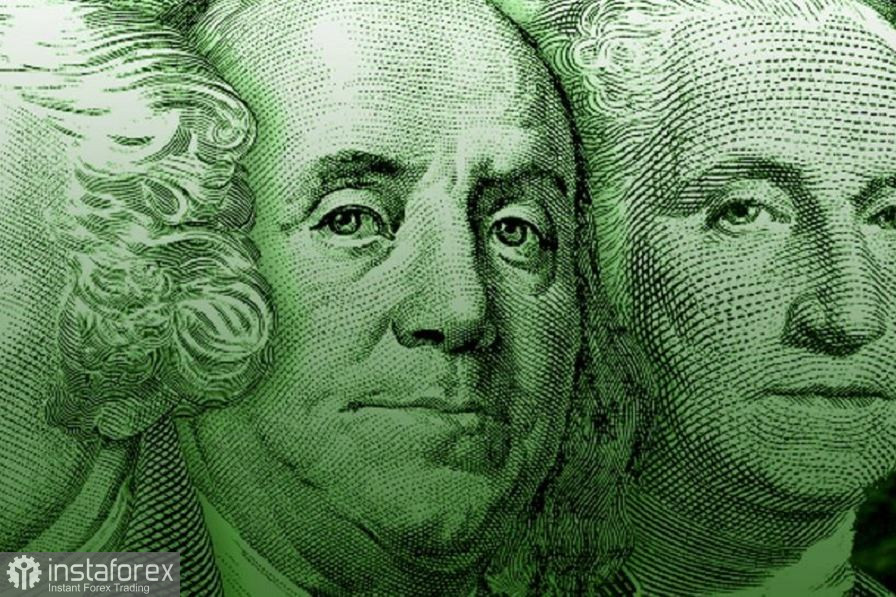The EUR/USD pair concluded the trading week on a minor note after briefly climbing towards the mid-1.10 level. EUR/USD buyers couldn't sustain their positions, and as expected, sellers took the initiative, pulling the price down to the 1.0946 target. This marked the end of a rather contradictory trading week. From a formal standpoint, the round ended in favor of the sellers - the weekly chart paints a bearish candle (opening price – 1.1017, closing price – 1.0946). But in reality, the pair is treading water, trading in the range of 1.0950 to 1.1050. Against the backdrop of euro-positive (or dollar-negative) news, the price initially rises, and then the EUR/USD bears reclaim lost ground with interest. This pattern has been in play for two weeks now, throughout August. The US inflation reports published on Thursday and Friday left more questions than answers: they didn't assist either the EUR/USD bulls or bears. All other fundamental factors played more of a supporting role. In practice, traders were unable to determine the price's direction.
China and Moody's
Looking at the weekly EUR/USD chart, we observed that despite trading in the 1.0950 - 1.1050 range, it clearly gravitates towards the lower band of the price range. This "attraction" is primarily due to the positions of the US dollar, which despite everything, retains its resilience. The increased demand for safe-haven instruments also plays a significant role in this.
For example, China was a disappointment this week, triggering a rise in risk-off sentiment. China's external trade volume continues to decrease: from January to July of this year, it amounted to $3.4 trillion, which is 6.1% less than the same period last year. Imports for this period fell by 7.6% year-on-year, while exports dropped by 5%. Even within a single month, the situation isn't better: in July, China's external trade volume reached $482.9 billion - 13.6% less than in July of the previous year and 3.4% less than June 2023. This result was concerning as it indicates a slowdown in demand. The deceleration in imports signifies sluggish domestic demand in China, while the export slowdown, in turn, reflects weakened global demand. The general (disheartening) conclusion is that China is slowly recovering from the "COVID period," and this fact has a negative impact on the global economy.

Thanks to the surge in risk-off sentiment, sellers renewed the week's low, reaching the 1.0930 mark. Rating agency Moody's supported the dollar when it reminded the market of a banking crisis. The agency downgraded the ratings of 10 small and medium-sized banks by one notch and announced a review of ratings - downward for 6 financial institutions, among which are quite well-known ones (Bank of New York Mellon, US Bancorp, State Street). This news intensified the risk-off sentiment in the markets.
However, China and Moody's were only in the spotlight in the first half of the week. Then, the focus shifted to US inflation data.
CPI, PPI, and Federal Reserve comments
Looking ahead, it's necessary to note that by the end of the week, the market had not formed a unanimous opinion regarding the trajectory of US inflation. On one hand, the Consumer Price Index demonstrated an uptrend for the first time since June 2022 after 12 consecutive months of decline. The index reached 3.2% (with a forecast at 3.3%). On the other hand, the Core CPI hit 4.7% (forecast at 4.8%), which showed a downtrend. The index has been decreasing on a yearly basis for the fourth consecutive month, reaching its lowest value since November 2021 in July. It's worth recalling that at the end of July, the Core Personal Consumption Expenditures Index, a crucial inflation indicator for the Fed, also showcased a downward trajectory, dropping to 4.1% - the slowest growth rate for the indicator since October 2021.
The fundamental puzzle became more complex after the release of another inflation report. The Producer Price Index. All its components were in the "green" - the first time in the past year. For example, the index, on a yearly basis, grew by 0.8%, surpassing the forecasted growth of 0.3%. The indicator had been consistently decreasing for 12 months, but unexpectedly increased in July.
After some fluctuations, traders ultimately interpreted the inflation reports in favor of the US dollar, although after the release of the CPI, the greenback weakened across the market.
However, despite the dollar's actual victory at the end of the past week, it's premature to claim a shift in favor of EUR/USD bears.
Firstly, the sellers were unable to establish a foothold near the 9th figure's base, despite attempting to do so multiple times during the week.
Secondly, there is still intrigue regarding the Fed's response to the July inflation figures. Fed officials may focus on the deceleration of the core CPI and the core PCE Index, leaving the growth of the CPI and the PPI on the sidelines. Such a scenario is also possible, given the cautious comments voiced by the Fed officials. Particularly, the President of the Federal Reserve Bank of Philadelphia, Patrick Harker, stated the first signs of victory for the Federal Reserve, citing progress in the realm of inflation. Similar rhetoric was echoed by his colleague from the Federal Reserve Bank of Atlanta, Raphael Bostic.
It's also worth noting that according to the CME FedWatch Tool, there is only a 10% chance of a quarter point rate hike (with the probability of keeping rates unchanged at 90%). This indicates that the inflation reports did not reinforce hawkish expectations regarding the Fed's future course of actions - at least in the context of the September meeting.
This situation can change if Fed officials, in majority, tighten their rhetoric. But as of "now," this hasn't occurred, and therefore, the dollar still appears vulnerable. It's plausible that in the medium-term perspective, the EUR/USD pair will trade within the range of the 9th figure, with occasional moves toward the 1.1000 - 1.1050 range.





















